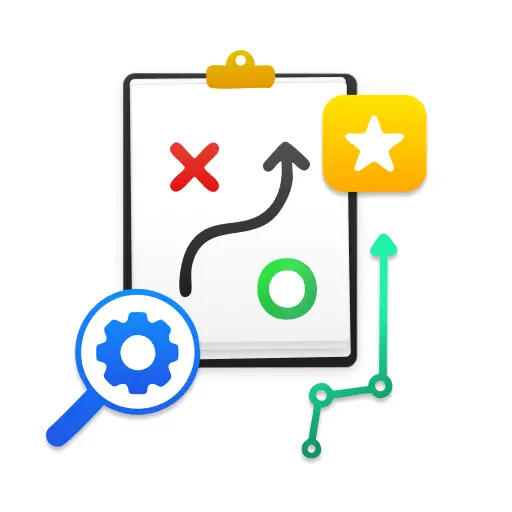We’re grateful to welcome back Amanda King, who has buckets of expertise dealing with enterprise businesses, to share what she considered the hallmarks of good enterprise SEO management.
Search engine optimization is an ever-changing and evolving discipline, which can make it difficult for some folks to feel like they’re doing more than just “treading water.” Working at or with an enterprise company adds another layer of complication on top. But that’s why I’m here, to share ways to ease the path to success at an enterprise level for you and your colleagues.
In this article, I’ll share what successful enterprise SEO management looks like, and the ways we can implement this in our day-to-day or the shifts we may want to make in our perspective. Fair warning, a number of the things which make an enterprise SEO engagement successful – in-house or agency – are soft skills. After a certain point success is not defined by whether or not you can write the most perfect JavaScript function. It becomes about how you share what you want to get done and why it will benefit the business.
Contents:
- Understanding the infrastructure
- Practice over theory
- Business context alignment
- Skillful language and communication
- Flexibility and compromise
Understanding the Infrastructure
The first thing we’ll discuss is less a specific hard skill and more the “hard facts.”
Enterprise infrastructure can be complex and convoluted. Maybe you use Google Analytics for 75% of your website, but there’s a legacy section of it that’s published on Adobe Experience Manager, so that portion of the site reports only through Adobe Analytics.
Maybe the dev team is in the midst of migrating the framework the site is built on, and right now only about a third of it is done, so there are a few weird bugs but they should only be temporary.
Maybe the server is an old LAMP stack in the basement and it doesn’t have capacity to hold more than a day’s worth of server logs at a time. Or maybe you don’t have a single file that manages your redirects and they’re scattered across a bunch of different legacy platforms and the developers haven’t had the bandwidth to migrate them into one because there’s not a regex expert. (And yes, if it sounds like these are specific examples, they’ve all happened to me or my colleagues).
Learning how your enterprise website is built and, if relevant, physically housed, can help your understanding of:
- The maturity of the digital teams
- The appetite for risk or change by leadership
- Context into how easy or difficult traditionally “low-hanging fruit” SEO tasks would be
Understanding all of this together gives you a new set of assumptions about getting things done at an enterprise level. Every quirk is unique.
Practice Over Theory

We can think of “practice over theory” as prioritising action, even when we’re looking to prove a point. What do I mean by that? Say you’re in-house and you want to change the product page layout to include more of the product specs data in a bulleted list, along with product-led FAQ and a few other changes.
So you search the internet and find a few product page case studies from Search Pilot that are kind of aligned with what you’re trying to do, and use that as a part of a long email to your boss about why you want to do this on the product pages. But then it stalls from there because your boss would have to put it in front of the financial board and they’re really not keen on that because they just asked for budget for a new project for the CMS migration, so the idea gets put on a shelf in the back of your brain and your to-do list until you get asked whatever happened to it at your annual review.
Instead, imagine if you proposed a proof of concept—that you take your third or fourth most popular product and make those changes you propose to that page, with proper tracking in place, either through manual SEO A/B test calculations using CausalImpact, or an SEO A/B testing platform.
You’d need to speak to your development team and their associated product manager, but if you frame it as a relatively harmless thing that could also benefit them (we’ll talk about communication more in a later section), you’ll likely be able to get it done. And your boss doesn’t have to go to the financial review board with an unproven idea, instead, once you do the proof of concept, you’ll have a grounded, recent example of the kind of impact the changes you want to make could have on the whole website.
Let Go Of The Small Things
Enterprise sites are massive. You will need to learn to do things at scale, and will probably need to learn to use new tools— and potentially pay more for existing ones. But the ability to analyse at scale might be an absolute gamechanger, because you’ll be able to see at-a-glance how much of the site is impacted, and prioritise from there.
Editor’s Note: For example, you’re likely to need an enterprise-level website crawler, like Sitebulb Cloud, in order to crawl such a massive website(s) at scale.
What this also means, whether you’re in-house or agency, is you need to focus on the work that, in your experience, will make an impact. So whether you use an Einstein matrix or your own system to determine what is important, do that prioritisation, and put it in play.
It means things like shortening meta descriptions or experimenting with title tags will probably be put in the “when I have a free thirty minutes” bucket, and aren’t an official task to get done that you’re putting your budget and time against. If you’re an enterprise SEO or working with an enterprise SEO client and are looking at fixing best practices that account for less than 10% of the website, you probably want to re-align your priorities.
Understanding the business is one way to make sure your priorities align.
Business Context Alignment
One of the best ways to get a proof of concept or test approved is if you can line it up to the business priorities and what they’re trying to build, or what work is planned for the year.
If, for example, the enterprise is looking to move to a new CMS in six months, a developer intensive project you want to do to refactor the JavaScript on the page to increase page speed by 0.5 seconds would likely not happen. That’s a lot of sunk cost—a lot of work to put into a system that will be switched out with an entirely different one in less than a year.
Or, say, you know the company wants to start building out a gaming arm, and you’re still focusing your tactical work on the product line that’s going to be retired to shift focus to gaming…well, that might not be the best idea to get your work approved and implemented.
If you’re working at an agency for an enterprise company, include questions around business context in your onboarding of the enterprise client. If you’re working at an enterprise, you should get a lot of this context in your own onboarding.
Regardless of how much of this information you get at the start, my general advice for staying across the changes and shifts in your business strategy, goals and targets is to be social! Talk to other departments, introduce yourself to your traditional marketing team, grab a coffee with your backend engineers or QA team…diversify who you spend time with. If you can, meet folks in person. It provides a more human face to a small ask or big request that might otherwise just feel like lines of code on a screen: we want to evoke empathy and emotion when we engage with the business and its story, not just data.
Empathy is a shortcut to trust. Building your business understanding allows you to create empathy in the right directions: rather than your nuanced, discipline specific language, you’re starting to speak the language of the business, and what matters to other folks.
Skillful Language and Communication
Now that we have an idea for a relevant proof of concept, we understand the business context, and that it’s important to use more than just data when trying to get things done, that all needs to wrap into our language and communication.
Some folks early in their career may want to lean on “it depends” and write long emails explaining the logic of a decision, or share all of the different options so the person on the other end has the “full picture.” That is a one-way ticket to the abyss that is emails in the “I’ll read that later” bucket for your stakeholders. Why?
Because it’s too long.
Because we’re presenting the problems and not the solution.
Because we’re listing out scenarios they don’t fully understand and don’t care about.
Because there’s no clear ask.

When you’re communicating up and out, even if that’s with your boss, be as decisive as possible. If you want their approval for a proof of concept, I’d say keep your email to 2-3 lines maximum, fully framed within their business goals and targets:
- Start with the ask: “I would like your approval to include this in the backlog of the EX-7 development team.”
- Next, the hypothesis and benefit: “The hypothesis I want to test on our z product page is that if we have more specs data and product-led information, we’ll get an incremental 10% in sales through organic channels.”
- Finally, any further context: “I’ve already spoken to Sally, and she estimated it would take the approx 2 weeks to do at their current capacity, still leaving a 10% buffer in their backlog for drop-in work.”
It does nobody any favours to write long emails. Just think how you feel when you read them—dread probably pools in your stomach a little bit, right?
Now imagine you’re someone with even less time in the day with probably triple the number of emails to try and get through, while also making decisions daily that will affect the course of the business and whether or not the department meets their target this year. Respect your stakeholder’s time.
Part of respecting their time is also respecting our own proactivity. We want to anticipate questions or concerns and address them on our own terms rather than waiting until they ask the question. As many of us with anxiety know, waiting to rip off the band-aid is usually more nerve-wracking than actually ripping off the band-aid.
Most frequently, managing up like this happens with your direct manager—or if you’re an agency working with an enterprise, your client. Talk to them regularly about what you’re doing, in fact, I default to over communicating rather than not. Including where you need help or where you’re hitting roadblocks—but remember, do your research and go in with a proposed solution first. Otherwise, particularly if we do this over email, it can read as complaining, which nobody is really a fan of.
This decisive, proactive, solution-led overcommunication is an approach to apply to any and all dealings within the business, whether that’s in casual conversation, scheduled meetings, presentations, or emails.
Flexibility and Compromise
Finally, working with an enterprise business requires a lot of compromise.
As organisations get larger, by their very nature, there are fewer things within your immediate control as a specialist.
For SEOs, this also means there are fewer things that we can say we’re an “expert” in. We don’t know all of the legal or procurement requirements backwards and forwards, nor do we know our entire legacy codebase. There’s much more history and context for enterprise companies generally. So while the docs of the JavaScript framework or script you’re working with may describe a particular function as possible, or best practice, it may not play well with the rest of your website, like conflicts with medications. You’re not the pharmacist, so you probably don’t realise there’s a conflict until the team tells you.
So when you’re working at an enterprise company rather than being strict about what the end solution you’re trying to get to looks like, aim to have an open conversation with the experts in your company and create the solution with them. Come in with a proposed solution, but know it will probably change relatively quickly based on their feedback and their own expertise.
Listen, ask questions, and be curious. Everyone in the room is generally pulling in the same direction for the success of the company, so go in with the assumption of good faith.
When you do go into those conversations with an action plan, a solid understanding of the business and where they want to be in the future, as well as how to proactively communicate the solution you’re aiming for in relevant KPIs, you’re well on your way to success as an enterprise SEO.
To Summarise
One of the hallmarks of enterprise, full stop, is people. And the more people there are, the more important it is that we understand how to communicate clearly and decisively to them, because they’ll be the ones deciding whether or not things get done.
And to be clear and decisive when we work with others, we need fuller context, both for ourselves and for our stakeholders. We want to have an unimpeded understanding of the company so we can offer specific recommendations grounded in what’s important to the business and present it in the language of our stakeholders. While that can take years to build and finesse, the concepts we include in this article is a strong start to shifting the way we as industry professionals think and interact in our day-to-day.
You might also like:

Sitebulb is a proud partner of Women in Tech SEO! This author is part of the WTS community. Discover all our Women in Tech SEO articles.

Amanda King has been in the SEO industry for fifteen years, has worked across countries and industries. She offers strategic consulting through her business, FLOQ, and has a self-paced business-led strategy course for SEOs looking to flex those muscles and accelerate their careers. Amanda has been focused on the product, the user and the business, incorporating data & analytics, user experience and CRO alongside SEO. Always happy to trade war stories, find her on LinkedIn for intermittently shared advice and thoughts on the industry.
Articles for every stage in your SEO journey. Jump on board.
Related Articles
 SEO Storytelling: Turning Jargon into Stories that Win Sprints
SEO Storytelling: Turning Jargon into Stories that Win Sprints
 Enterprise Local SEO for Luxury Kitchens & Bathrooms in London
Enterprise Local SEO for Luxury Kitchens & Bathrooms in London
 Enterprise SEO Challenges: The Complexity Tax & How To Break Free
Enterprise SEO Challenges: The Complexity Tax & How To Break Free
 Sitebulb Desktop
Sitebulb Desktop
Find, fix and communicate technical issues with easy visuals, in-depth insights, & prioritized recommendations across 300+ SEO issues.
- Ideal for SEO professionals, consultants & marketing agencies.
Try our fully featured 14 day trial. No credit card required.
Try Sitebulb for free Sitebulb Cloud
Sitebulb Cloud
Get all the capability of Sitebulb Desktop, accessible via your web browser. Crawl at scale without project, crawl credit, or machine limits.
- Perfect for collaboration, remote teams & extreme scale.
If you’re using another cloud crawler, you will definitely save money with Sitebulb.
Explore Sitebulb Cloud

 Amanda King
Amanda King


